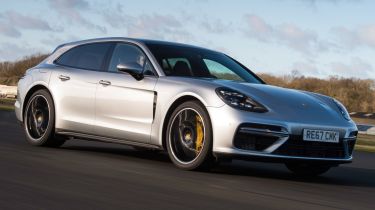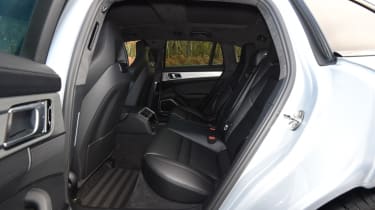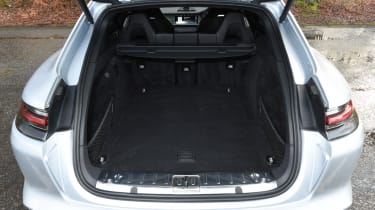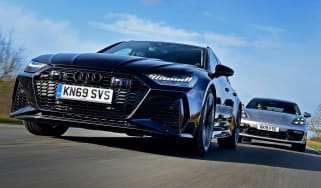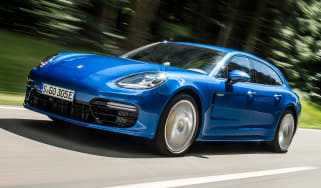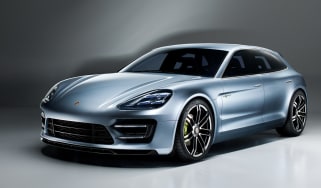Porsche Panamera Sport Turismo review
With powerful engines, a sublime chassis and a luxurious interior, the Panamera Sport Turismo could be the ultimate executive express

The Porsche Panamera Sport Turismo builds on the success of the standard Panamera and offers enhanced accommodation and arguably a more stylish exterior, too. But it’s likely the most compelling reason to buy a Sport Turismo is for the driving experience – just like the standard Panamera, it combines excellent all-wheel-drive traction with a level of precision and agility you wouldn’t have thought possible from such a large luxury car.
The Sport Turismo commands a small price premium – just over £2,000 in most cases – over the ‘regular’ Panamera, but we feel it’s worth paying for the extra space on offer.
It’s not often that a sports car manufacturer successfully moves into other market segments, but Porsche has now done it on several occasions. Its long-running rear-engined 911 model still sets the standards by which other sports cars are judged and its Cayenne and Macan are among the best offerings in the luxury SUV market.
Then there’s the Panamera, which has carved a niche for itself in the luxury sports saloon market. The Panamera ‘saloon’ (it’s actually a hatchback) has competitors in the shape of the Audi A7 Sportback and Mercedes CLS, but this version, the Panamera Sport Turismo, with its shooting brake styling, stands as a unique proposition in today’s market. It has very few direct rivals, if any at all, and is a very appealing prospect in its own right.
Used - available now

2020 Jaguar
F-Pace
41,363 milesAutomaticDiesel2.0L
Cash £17,500
2023 Volvo
V60
52,597 milesAutomaticPetrol2.0L
Cash £18,999
2022 Volkswagen
ID.4
14,603 milesAutomaticElectric
Cash £18,897
2023 Hyundai
Tucson
16,735 milesAutomaticPetrol1.6L
Cash £24,176The Sport Turismo is based on the standard Panamera rather than the extended-wheelbase version, but it’s still a very large car – more than two metres long and almost two metres wide. It does offer some space advantages over the regular Panamera, with slightly improved rear headroom and a marginally larger boot, plus it has what Porsche calls a ‘4+1’ seating arrangement; the Panamera saloon is a strict four-seater.
It’s likely that many buyers will opt for the Sport Turismo for its styling, though – the shooting brake design is rare these days, and the higher roofline and semi-estate profile endow the car with a more cohesive look than that of the normal Panamera.
Despite dropping diesel-engined models from its line-up, Porsche still offers plenty of choice under the bonnet of the Sport Turismo. The range comprises six models. The £75,000 Panamera 4 and the £96,000 4S feature turbocharged V6 engines, delivering 325bhp and 434bhp respectively, but the real performance powerhouses are the GTS and Turbo models, both of which use a 4.0-litre V8 for outputs of 454bhp and 542bhp.
There are also two plug-in hybrid variants: the £86,000 Panamera 4 E-Hybrid and the range-topping Turbo S E-Hybrid with a price tag of over £140,000. The main advantage these two models have is that, thanks to lower CO2 emissions, they are considerably more attractive as company cars, as well as offering better fuel economy. The downside is that they are less engaging to drive than other versions of the Panamera due to the extra weight of their electric motors and lithium-ion batteries.
This is a shame because the petrol-engined Sport Turismo models are as much fun as their saloon counterparts. No car of this size and weight has the right to be quite so agile and entertaining. Straight-line performance is exceptional, but the Porsche’s real party piece is the way it can hide its bulk when being driven enthusiastically. And if you specify air suspension (optional on the 4 and 4S, standard on the more expensive models), the ride quality is excellent, too; the Sport Turismo is comfortable when cruising but offers exceptional body control when pressing on.
As if the style and performance weren’t enough, this Panamera also offers a sublime interior, packed with the latest Porsche infotainment system and finished off with exceptional materials and excellent build quality. It all comes at a price, of course, but the Sport Turismo really is a quite exquisite machine.
Engines, performance and drive
Given that Porsche made its name manufacturing sports cars, it should come as no surprise that its SUVs, saloons and estate cars follow the same path, offering levels of driver involvement not generally associated with these types of vehicle. And this holds true for the Panamera Sport Turismo, too.
Within the six-model range there are some differences to be noted depending on suspension set-ups and powertrains. But the overriding impression is that this two-tonne executive express rides, handles and performs with aplomb whether you opt for the entry-level Panamera 4 or the top-spec Turbo S E-Hybrid.
Perhaps what impresses most is the Sport Turismo’s agility – for a big, heavy car it handles exceptionally well, turning into bends with verve and composure, accompanied by exceptional levels of grip thanks to its four-wheel-drive system. The steering is nicely geared and well weighted, and if you go for the optional rear-wheel steering the Sport Turismo feels like an even more keenly sporting machine.
The E-Hybrid models aren’t quite so finely honed as the conventionally powered models, thanks to the additional weight they have to carry around. The range-topping Turbo S E-Hybrid tips the scales at over 400kg more than the entry-level Panamera 4 Sport Turismo, and this extra weight can be felt when cornering at speed, even though the flagship model has more sophisticated air suspension rather than the more basic car’s steel spring set-up.
That air suspension is an option on the Panamera 4 and 4S models, but is included as standard on the rest of the range. It’s worth having because it does help the Sport Turismo to ride with significantly more composure than the cars with the standard set-up, especially if large 21-inch wheels are fitted. In Normal mode, the Sport Turismo with air suspension has a remarkably fluid ride quality, with only the worst of potholes sending a shudder through the cockpit. In Sport or Sport Plus modes it’s considerably firmer and allows more minor road imperfections to be felt, but the flip side of this is superior body control when cornering.
Engines, 0-60 acceleration and top speed
Despite Porsche shunning diesel power these days, there are still six models to choose from and even the entry-level £75,000 Panamera 4 Sport Turismo offers 325bhp and 450Nm of torque. That’s enough to propel it from 0-62mph in 5.5 seconds and onto a top speed of 160mph. The 4S features a reworked version of the 4’s 3.0-litre V6 for an output of 434bhp and maximum torque of 550Nm. Its 0-62mph time drops by over a second to 4.4 seconds and top speed rises to 177mph. You’ll pay an additional £21,000 for the privilege, though.
The other two conventionally powered Sport Turismos, the GTS and the Turbo, both use a twin-turbo 4.0-litre V8 in different states of tune. The GTS has 454bhp and 620Nm of torque to deliver a 4.1-second 0-62mph time. Meanwhile, the Turbo packs 542bhp and 770Nm for a 3.8-second sprint time. Top speeds are 179mph and 188mph respectively.
Porsche also has two plug-in hybrid models in its Sport Turismo range. The Panamera 4 E-Hybrid uses the Panamera 4’s V6 biturbo engine allied to an electric motor for combined maximum outputs of 456bhp and 700Nm of torque. It covers 0-62mph in 4.6 seconds. The range-topping Turbo S E-Hybrid matches the Turbo’s 4.0-litre V8 with an electric motor for a colossal 670bhp and 850Nm of torque, which is enough for a benchmark sprint time of 3.4 seconds.
While the Turbo S E-Hybrid is undoubtedly the fastest choice in the line-up and the Panamera 4 E-Hybrid the greenest, most frugal and company car tax-friendliest, the hybrid models don’t quite offer the perfect Panamera driving experience. Their overly complex drive modes do take a little away from the fun behind the wheel.
MPG, CO2 and Running Costs
While the Panamera 4 E-Hybrid might not be the best driver’s car in the Sport Turismo range, it is likely to be the most popular model thanks to its lower running costs. If you have a relatively short commute you can take advantage of its all-electric running capability, and with a WLTP economy figure of between 78.5 and 85.6mpg, it offers significant fuel savings over its conventionally powered cousins. It’s also by far the most cost-effective machine in terms of Benefit-in-Kind (BiK) company car tax with a 16 per cent BiK rate thanks to its 60-62g/km CO2 emissions figure.
Despite its monumental performance, the Turbo S E-Hybrid could also potentially be a relatively ‘sensible’ purchase, with official economy figures of between 72.4 and 74.3mpg and a BiK rating of 19 per cent. However, the purchase price of over £140,000 means company car tax will still be a hefty proposition. And, naturally enough, if you use its performance potential you’re highly unlikely to achieve anything near those official economy figures
The four conventionally-powered Sport Turismos are closely matched on official WLTP economy figures, with the 4 and 4S being marginally more fuel efficient that the two 4.0-litre V8s in the GTS and Turbo. Best economy is quoted at 25.6mpg for the Panamera 4, while the Turbo and GTS have worst-case official figures of 22.2mpg. As with the Hybrid models, should you delve into their considerable performance envelopes you’ll return significantly worse economy.
All Sport Turismos bar the E-Hybrids attract a BiK rate of 37 per cent, which will make them an expensive company car choice. Thanks to their high prices, models with purely internal combustion engines attract high annual VED rates of £450, while buyers choosing the hybrid models face bills of £440 a year.
Insurance
As you might expect, a sporting estate with high levels of performance and high purchase prices is going to be expensive to insure. Every model in the Sport Turismo range falls into the top insurance bracket, group 50, so you’d be wise to get some quotes before signing on the dotted line.
While the Panamera Sport Turismo has very few direct competitors, most cars in this price range and with this performance potential will attract similarly high insurance rates. In addition, most insurers will probably require a Thatcham-approved tracking system to be fitted.
Depreciation
As the Sport Turismo is still a very new car, it’s difficult to gauge how it will perform in regard to depreciation. But for the hatchback Panamera, the residual value after three years is expected to be between 48 and 53 per cent. While this will represent a significant sum of money, it is better than average for the class where expensive models traditionally depreciate quite heavily during their first years on the road.
To get an accurate valuation on a specific model check out our free car valuation tool...
Interior, design and technology
While the first-generation Panamera had a decent cabin, the second-generation model on which the Sport Turismo is based features an even better interior design, blending sporting pretensions with generous accommodation and a host of technology.
All models come with comfortable electric seats and every driver, no matter their size or shape, should be able to find their optimal driving position. Porsche has also taken criticisms of the original Panamera on board, and as a result there are significantly fewer buttons clustered around the centre console to contend with. So finding the function you are looking for is far less confusing.
The buttons that do remain are touch sensitive and covered by a sophisticated glass panel which provides a top-quality feel. And that’s a theme repeated throughout the cockpit – high-grade materials are used and the attention to detail is second to none. There’s a nice approach to the traditional Porsche instrumentation, with the centrally positioned analogue rev counter now flanked by a pair of seven-inch digital screens whose content is customisable by the driver.
The one on the right can feature information such as the sat-nav map, fuel gauge, on-board computer, range, economy and the like. The one to the left encompasses the speedometer, speed limit and traffic sign recognition, as well as cruise control information. The overriding impression is of a very slick driving environment with everything you need falling easily to hand.
Sat-nav, stereo and infotainment
Along with the Sport Turismo’s pair of digital screens flanking the rev counter, you get a centrally mounted 12.3-inch touchscreen that operates a plethora of functions and acts as the hub for the Porsche Communication Management. As you’d expect there’s an intuitive factory navigation system that gives seamless route guidance, although these days owners will be more likely to use the standard-fit Apple CarPlay on a regular basis.
The system in the Panamera Sport Turismo is the most sophisticated multimedia set-up ever fitted to a Porsche, and it shows – you can connect to apps, use Google Earth and hook up to the built-in WiFi hotspot for internet access. It works beautifully and is very impressive.
Practicality, comfort and boot space
One of the main reasons for choosing a Sport Turismo over the standard Panamera is that the shooting brake styling gives the car an edge on practicality. The boot is a little larger, there’s a little more headroom in the rear and the Sport Turismo is also suitable for occasional five-seat use, whereas the Panamera hatch is strictly a four-seater. However, where the Panamera hatch is also available in long-wheelbase ‘Executive’ trim, which offers significantly more rear legroom, the Sport Turismo can only be ordered on the standard wheelbase.
There’s no doubting the Sport Turismo’s comfort levels, though; the seats hug and support you in all the right places and with the high centre console you feel cocooned when sitting in the driver or passenger seat. There’s plenty of storage space for oddments, too, with a cubby in the centre console and generous door pockets.
On the optional air suspension, the ride is excellent when in Normal mode, and you’re well insulated from wind noise, although tyre noise on the larger alloys can be a little intrusive on some surfaces.
Dimensions and size
There’s no escaping the fact that the Sport Turismo is a very large car – it’s over five metres long and nearly two metres wide, so it can be a bit of a handful when threading your way through city streets or negotiating width restrictions. By way of comparison, the Panamera is almost identical in size to a BMW 7 Series saloon.
Nevertheless, visibility is actually quite good, even though the car doesn’t have a huge glasshouse, and while you’ll need a large space in which to park, manoeuvring into it isn’t too much of a battle.
Leg room, head room and passenger space
As you’d expect from a vehicle with these dimensions, the interior accommodation is pretty accomplished, although for a car of this size its ‘4+1’ seating arrangement is perhaps a bit of a disappointment. But this is how Porsche describes it and, in effect, it means the middle ‘seat’ in the rear is only to be considered for occasional use; a trip to the pub would be fine, a cross-continent drive would not.
Legroom for the two outer rear passengers is more than adequate and the Sport Turismo’s raised roofline does offer a little more in the way of headroom for passengers in the rear.
Boot space
Another perceived advantage of the Sport Turismo is that its shooting brake styling will offer a bigger boot than in the Panamera hatch, and it does, but probably not by as much as you might be thinking.
In the Sport Turismo you get between 520 and 1,390 litres of luggage carrying capacity, which is between 20 litres (with the seats up) and 50 litres (when they’re folded) more than in the standard Panamera. However, slightly more bulky items can be carried and the 40:20:40-split folding rear seats do make it a more practical proposition. The seats also fold virtually flat, which is a bonus when carrying larger items.
Reliability and Safety
The Panamera doesn’t sell in large enough numbers in the UK to have featured in our Driver Power 2018 satisfaction survey, and we didn’t receive enough responses from owners for Porsche to have ranked among more run-of-the-mill manufacturers. But the brand is well respected within the industry for its engineering excellence, so we don’t have any qualms about the reliability of the Sport Turismo.
As far as safety is concerned, the Sport Turismo does come with all the expected stability and traction control devices and has a comprehensive selection of airbags, too. However, while the car is undoubtedly surefooted, most safety enhancing systems that you might expect to be standard equipment are to be found on the options list. On the entry-level Panamera 4, for example, you’d need to spend an additional £795 for a lane keeping assist system, £617 for a lane changing assist system and an eye-watering £2,438 for its most advanced active cruise control set-up.
It’s unlikely the Sport Turismo will be tested by the safety experts at Euro NCAP, but the Porsche Cayenne was assessed in 2017 and achieved the full five stars, so we’d expect the Panamera Sport Turismo to offer similar levels of protection in the event of an accident.
Warranty
Porsche’s new car warranty lasts for three years and has no mileage restriction.
Servicing
Porsches tend to be more expensive to maintain than some of their mainstream competitors, although they are not in the same category as some Italian supercars. Main service intervals on the Sport Turismo are every 20,000 miles.
